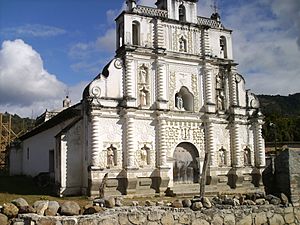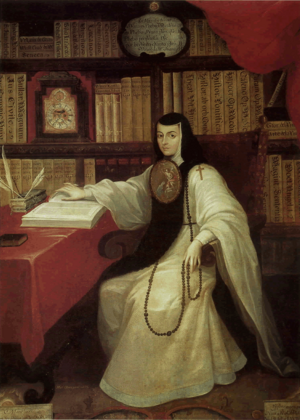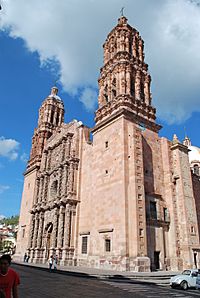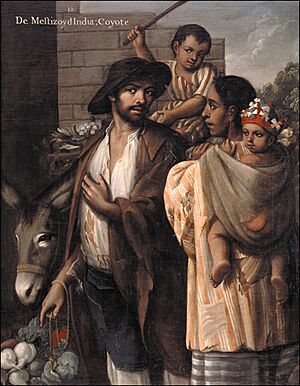New Spanish Baroque facts for kids

New Spanish Baroque, also known as Mexican Baroque, is a special style of art from the time when Mexico was called New Spain. This was a period when artists in New Spain tried out new ways to create art. They made art that was very expressive, used strong contrasts, and looked very realistic. This style became super popular across New Spain.
Many artworks from this time are colorful sculptures. These sculptures show amazing skill. They also reflect the strong feelings and bright color differences that are typical of New Spanish Baroque art.
In architecture, two main styles developed in New Spain. The Salomónico style started in the mid-1600s. The Estípite style began in the early 1700s.
The Cathedral of Puebla is a great example of the grand architecture of New Spain. Music was also very important during the Baroque period in colonial Mexico. We know this from an 18th-century choir book and a harpsichord.
Painting in New Spanish Baroque
New Spanish Baroque painting featured many talented artists. Their works can be seen in museums today. Some of these museums include the Museum of the Viceroyalty in Tepotzotlán, El Carmen Museum in San Ángel, and Santa Mónica Museum in Puebla. You can also find their art in the Metropolitan Cathedral in Mexico City.
Some of the most famous painters were:
Simón Pereyns: A Flemish Painter in Mexico
Simón Pereyns was a painter from Flanders, a region in Europe. He was born around 1530 in Antwerp and later moved to Mexico around 1600. In 1558, he went to Lisbon and then to Madrid, where he worked for the royal court.
In 1566, Pereyns traveled to New Spain. He became very famous for his paintings there. Many of his works have been lost over time. However, some still exist, like ten panels from the altarpiece of Huejotzingo (1586). These show the influence of another famous artist, Dürer. His painting of Saint Christopher (1585) is also well-known.
Pereyns faced some difficulties in Mexico. He painted a picture called "Our Lady of Atonement" during a challenging time. He hoped it would help him. He was later released and gave the painting to the Archbishop of Mexico. This painting is now on the Altar del Perdón at the Metropolitan Cathedral.
Juan Correa: Master of Religious Art
Juan Correa (1646-1716) was a painter from New Spain. He was active between 1676 and 1716. His paintings covered both religious and everyday topics. One of his best works is "Assumption of the Virgin" in the Mexico City Cathedral. Several of his paintings of Our Lady of Guadalupe were sent to Spain. He also created paintings of Our Lady of Guadalupe in Rome in 1669.
Cristóbal de Villalpando: A Leading Baroque Artist

Cristóbal de Villalpando (c. 1649-1714) was one of the most important painters in Mexico City in the late 1600s. His early work includes 17 paintings for the main altar of the Franciscan convent of St. Martin of Tours in Huaquechula in 1675. He was likely born in Mexico City in 1649. We don't know much about his early life, but he married María de Mendoza in 1669 and had four children.
The council of the Mexico City Cathedral asked Villalpando to paint a series of large pictures. These were meant to decorate the sacristy walls of the church. Some of these paintings include "The Triumph of the Catholic Church" and "The Triumph of St. Peter." Unfortunately, he couldn't finish all six paintings due to problems with the building. Another artist, Juan Correa, completed the set.
Because of this, Villalpando moved to Puebla de los Ángeles. There, he did similar work at the Cathedral. He created a famous oil painting called "Glorification of the Virgin" in the dome of the Chapel de Los Reyes. Many of his works are also found in the church of the Profesa in Mexico City. Villalpando was highly respected by other painters and led their guild many times. He was a major influence on younger artists. He is seen as one of the last great Baroque painters in New Spain. After he died, art in New Spain began to change.
Miguel Cabrera: Master of Color
Miguel Cabrera (1695-1768) was an incredibly productive artist. He was especially good at painting the Virgin Mary and other saints. He is considered the best colorist of the 18th century.
His paintings were very popular. Many convents, churches, palaces, and noble families asked him to create artworks for them.
Writers and Thinkers of the Baroque Era
Many poets and writers were part of the New Spanish Baroque tradition.
Gutierre de Cetina: A Poet's Journey
Gutierre de Cetina (1520 - 1557) was a Spanish poet. He was born in Seville, Spain, and later died in New Spain. He came from a rich family and spent a long time in Italy as a soldier. He also spent time at the court of the Prince of Ascoli, to whom he dedicated many poems.
Cetina returned to Spain in 1554. In 1556, he went to Mexico for the second time. He had been there before, between 1546 and 1548. He fell in love with Leonor de Osma. Sadly, he was badly hurt in 1557 in Puebla de los Angeles by a rival and died.
Juan Ruiz de Alarcón y Mendoza: A Playwright's Legacy
Juan Ruiz de Alarcón y Mendoza (c.1581 - 1639) was born in Taxco. He was a writer from New Spain during the Golden Age. He wrote many different kinds of plays. His comedy "La Verdad Sospechosa" (Suspicious Truth) is one of the most important plays from Spanish American Baroque theater. It is as good as the best works by famous Spanish playwrights like Lope de Vega.
Not much is known about Alarcón's early life. He studied at the Royal and Pontifical University of Mexico and later at the University of Salamanca in Spain. There, he studied law.
In 1607, he returned to New Spain. He tried several times to become a university professor but wasn't successful. He then moved to Madrid, Spain. This was when he wrote most of his plays. His early works, "Las Paredes Oyen" (Walls Have Ears) and "Los Pechos Privilegiados" (The Privileged), were quite successful. He became known in Madrid's literary circles. However, he often faced teasing because of his physical appearance and his origins from the Americas. He always responded to these attacks and kept writing.
Alarcón's health began to get worse in early 1639. He passed away on August 4, 1639.
Carlos de Sigüenza y Góngora: A Brilliant Mind
Carlos de Sigüenza y Góngora (1645 - 1700) was a very smart person from New Spain. He was related to the famous poet Luis de Góngora. His father used to teach the royal family in Spain before moving to New Spain.
In 1662, Sigüenza began his religious studies. In 1667, he left the religious order. He then returned to Mexico City and joined the Royal and Pontifical University of Mexico. In 1672, he became a professor of mathematics and astrology. He held this job for twenty years. In 1681, he wrote a book called "A Philosophical Manifesto" about comets. He wanted to calm people's fears about these space objects. Another scholar disagreed with him, but Sigüenza responded by publishing "Libra astronómica y philosóphica" (1690). In this book, he explained his ideas about comets using the latest scientific knowledge of his time. He mentioned scientists like Copernicus, Galileo, and Kepler.
In 1691, heavy rains caused floods, and a disease ruined the wheat crop. Sigüenza used an early version of a microscope. He found that tiny insects were causing the wheat disease. This disaster led to a food shortage the next year, causing big riots. People looted shops and set government buildings on fire. Sigüenza bravely saved the city library from the fire, preventing a huge loss of books. He estimated that about ten thousand people were part of the riot.
As the royal mapmaker of New Spain, he drew maps of the Valley of Mexico. In 1693, he went on an exploration trip to the northern Gulf of Mexico and Florida. He drew maps of places like Pensacola Bay. This trip might have inspired him to write about sea adventures in his work "Los infortunios de Alonso Ramírez" (1690).
In his later years, he spent a lot of time collecting information for a history of ancient Mexico. Sadly, he died before finishing this important work. When he died, he asked for his valuable library of over 518 books to be given to a Jesuit school. He also wanted his body to be used for medical research to find a cure for the disease that caused his death.
Sor Juana Inés de la Cruz: The "Tenth Muse"

Sor Juana Inés de la Cruz (1651 - 1695) is known as the "Tenth Muse" because she was so talented. She was born on November 12, 1651, and died in Mexico City on April 17, 1695. She was one of the greatest writers during the Golden Age. She loved literature from a young age. As a woman, she couldn't go to university. So, she started writing poetry, music, and books. She joined a convent, the Convento de San Jerónimo (Mexico City), which is now the University of the Cloister of Sor Juana.
Her works include "Redondillas" and "Al que ingrato me deja" (To the one who ungratefully leaves me). She even wrote a poem that became a Christmas carol called "¡Ah de las mazmorras!" (Ah dungeons!). At that time, women were not expected to be philosophers.
Sor Juana eventually stopped writing poetry to focus on her religious duties. She became known for saying, "I, the worst of all." In 1695, a terrible sickness affected Mexico City, including her convent. Sor Juana helped care for the sick until she also caught the illness and died.
See also
 In Spanish: Barroco novohispano para niños
In Spanish: Barroco novohispano para niños
- Baroque art in Mexico
- Churrigueresque
- Azulejo







